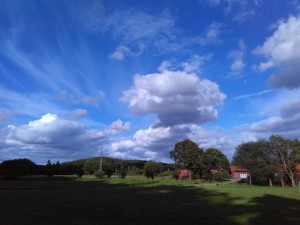
My first week in Sweden, where we are also thanks to project MAPI – Montessori Adolescent Programme Inspiration – Erasmus+ project of the Montessori School Andílek, is successfully behind me and I ask myself where I should start.
I arrived at a farm in Sweden on July 2, 2016, along with Táňa, a day early. No one expected us on the farm, so the presence of two Czech women was a big surprise for everyone. Jenny, who co-founded the school and farm, forgot to tell them about us:-). So we went for a walk to give them time to think about what to do with us.
They put us up in small rooms and split us into two separate rooms to make us speak as much English as possible.
Next day, more and more participants started slowly to arrive, and in the evening we all got together for dinner. We all had a name-napkin on the table, and so we slowly started to get to know one another. The same evening, we went to school for our first lecture, and also got more closely acquainted with the program of the first week.
For breakfast we had buns baked by the local students, and were informed straightaway that it was the last time they’d made them, because from next day on we would be making our breakfast and dinner ourselves. We also learned what our duties were (cleaning the rooms, kitchen, toilet, cooking, shopping, garbage disposal, tending the animals) and that we needed to make a schedule of what would be done, who would do it and when. Everything is entirely up to us, and if we want to eat and live like people, we have to cooperate as a group.
The first week at school was challenging – a lot of new information and a lot of new work, and it seemed to me that I was sitting at school 24 hours a day. I usually closed the computer late at night, because we were supposed to read some new articles for the following day. English was rushing through my head, so I couldn’t sleep at night. School started at 8:30 and we always had about three lectures in the morning. We had lunch at 12, and at 1pm we were again sitting by the computer, having a lecture or seminar. These usually finished at about five, followed by studying, writing a journal, or reading a book. And of course, someone had to cook, clean up or tend the animals. So there was no end to work.


The school in which I’m spending most of my time now
The weekend was challenging, too, because we had to write an essay about all that we’d heard in the first week and how we were going to use it when working with adolescents. That means to explain almost everything Maria Montessori wrote in forty years.
Otherwise, the community of people that met here are nice and everyone is trying to contribute as much as possible and engage in daily life. To live a life in a tiny room with four adults is not easy, but as they told us at the beginning, the room, and mainly the bed, is only here for us to go to sleep to.
The weather was fine in the first week, showers were brief, and I only got wet once. By the way, the countryside is beautiful and I have to say that I envy the children who spend so much time here. They don’t need civilization, shops, the internet. They have everything they need here. One another, nature, silence.

The two smaller buildings were built by children

Farm hidden behind trees
Renata Špalková, Táňa Kadlecová and Helena Matoušková from the Czech Republic took part at the AMI Orientation to Adolescent Studies (ages 12 – 18) in cooperation with NAMTA in July 2016 in Montessoriskolan Lära för livet, Rydet, Sätila, Sweden. The three ladies are all active in the growing Czech community of adolescent studies. In three places in the Czech Republic they build their Adolescent communities.
http://www.montessorimozaika.cz